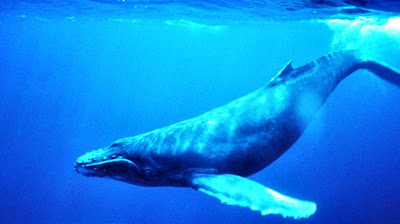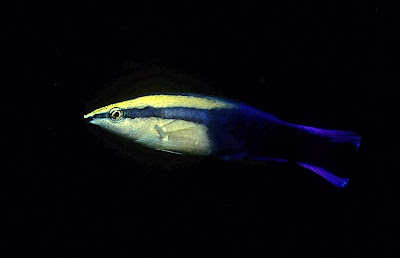by B. N. Sullivan
I should mention at the outset of this tale that, since Humpback Whales are a protected species, it is unlawful to pursue or otherwise interfere with them, either from the surface or underwater. People, whether on boats or in the water as swimmers or divers, are forbidden to approach "closer than 100 yards of any humpback whale or closer than 300 yards of a humpback mother and calf," according to the law.
On the other hand, the whales themselves are oblivious to (and excused from) such regulations. If they decide to, they are free to approach us, instead of the other way around. And once in awhile they do just that!

As it happens, our very first underwater whale encounter also was the most dramatic. Or perhaps it seems like that because like so many other 'first time' events in life, it left such a vivid and indelible memory.
Jerry and I were diving at
Puako, Hawaii near a certain underwater promontory known as Snapper Point. At the top of Snapper Point, a narrow plateau juts seaward like a coral-covered peninsula. The top of the plateau begins at a depth of about 20 meters (65 ft), then the terrain slopes down steeply to a depth of nearly 40 meters (130 feet), where it levels off, more or less, into a sand flat. It always has been a favorite dive: Swim from shore directly to the base of Snapper Point, have a look around at the sand community for a few minutes, then begin a gradual ascent along the steep and rocky slope to the plateau, finally moving across the coral gardens toward the shallows and shore. It's a classic multi-level dive.
Because
Snapper Point is sort of like the last outpost between the shore and the deep blue abyss, we often see big animals there. Sharks, eagle rays, mantas, amberjacks, barracuda, tuna and assorted pelagics cruise past Snapper Point frequently. We also see pods of dolphins in the area from time to time, and sometimes they see us, too, and dive down to look us over. In fact, the possibility of seeing big stuff is a main attraction for diving at Snapper Point.
Then one day at Snapper Point we saw the biggest of the big stuff.
On the day of our first whale encounter, we had completed the deepest part of our dive at Snapper Point, and we were coming slowly up the slope, poking lazily along, looking for shells and little critters on the rocky bank. Just like always.
We were a few meters below the level of the plateau when a shadow passed over us. We both stopped and looked up at the same moment -- just in time to see a full-grown Humpback Whale do a jackknife dive from the surface and glide down toward us. We were stunned.
The whale, which looked to be about the size of a city bus, leveled off just at our depth, at a spot maybe five meters in front of us. It stopped and held its position for a moment, pectoral fins akimbo, and with an eye the size of a basketball, it just looked right at us. I think we actually stopped breathing for a moment, and I'm sure that
our eyes, too, were about as big as they could get!
Next the whale drew its pectoral fins in to its sides, banked slightly to its right, and began to glide away. Only when it completed its turn toward the blue did it move its huge tail to propel itself. The last we saw of it was the white undersides of its enormous tail flukes -- easily 10 or 12 feet wide (although we didn't exactly get to measure!) -- beating up and down gently but purposefully as it left us.
That was the end of that dive for us. We could think of nothing but the whale, so we ceased our underwater sightseeing for the day and headed toward the shallows and our exit point.
One of the most striking things about that encounter, beyond the fact that the whale came so close to us in the first place, was noticing how graceful and agile it was. You'd think an animal so large would just lumber about -- a bull in a china shop, as it were. What we saw suggested anything but clumsiness. The whale dived just as deep as it needed to in order to inspect us. Then it paused, motionless, with what any diver would recognize as excellent buoyancy control. And when it left us, it made what can only be described as a precision departure. No thrash, no clunky moves. Clearly it was exquisitely aware of -- and in control of -- its body position, and that of its fins and tail flukes. That is what was so impressive, and what burned into our memory.
While that was our most dramatic whale encounter, it was not the last. On a number of occasions since then, we have seen whales underwater. Most encounters have happened while we were in buoy mode (which I described in the
previous whale post), positioned near a dropoff or near the top of Snapper Point, just waiting (and hoping) for the whales to pass by. Very often we would wait like that -- sometimes for up to an hour -- and see nothing but little fishies, or perhaps a manta as a consolation prize. But once or twice in a season a whale or two will swim past us at relatively close range, as if rewarding us for our dedication and patience.
Do they notice us? I have to say, yes, I believe they do. In some instances I have been completely certain that they noticed us. An example that comes to mind right away: Along with our friend Dan, we had spent about forty minutes one day, waiting in buoy mode over a certain dropoff, because we'd seen whales on the surface in that area, just as we were entering the water. It was a cold day, and eventually Jerry signaled that he was going to end his dive and swim to shore because he was too chilled. Dan and I were getting cold, too, but decided to remain at the dropoff awhile longer. Several more minutes went by, and then along came a pair of huge Humpbacks. They swam past, close enough that we felt turbulence. It was really exciting. Spontaneously and in unison, both Dan and I were 'punching the sky' in delight. And believe it or not, one of the whales slowed slightly and looked back at us momentarily, as if to say, "What in the heck is
THAT?!"
We have learned something about when to expect a whale encounter, or more correctly, when not to. We have noticed that when we hear the whales vocalizing, we never see them, even when the sounds are so loud that we imagine they must be just feet away. Without exception, every time we have come face to face with a Humpback underwater, it has been during an interval of whale silence. We think, perhaps, that they just don't vocalize much while they are swimming. Of course, neither do we.
About the Photo : I've never been able to photograph a whale underwater. Either I haven't had a camera when the whales appeared, or else I had a camera but it was set up for macro. I chose the photo above from the NOAA Photo Library. According to the notation there, the photographer was Dr. Louis Herman, who has had a long career studying the behavior, sensory processes and cognition of cetaceans. It seems fitting that we use Dr. Herman's photo to illustrate our story: When I was a graduate student at the University of Hawaii (UH), several visits to the Kewalo Basin Marine Mammal Laboratory in Honolulu, which Dr. Herman founded, gave me my first exposure to cetacean behavior. Dr. Herman is now a Professor Emeritus at UH.
Note: This is the third post in a series about the Humpback Whales that winter in Hawaii. In case you have not seen them, you may want to have a look at the two earlier episodes:- Tales of Whales: Humpbacks in Hawaii - includes a brief video of the whales, plus a link to a live web cam at Puako, where we dive. You may be able to see the whales for yourself if you are lucky!
- Tales of Whales: Vocal Visitations - tells of hearing the whales underwater, and includes a link so that you can listen to the whales' songs and vocalizations, just as we hear them underwater.
BNSullivan.jpg)
BNSullivan.jpg)
BNSullivan.jpg) This is the second in a series of posts intended to showcase the many colors and shapes of soft corals in the taxonomic family Nephtheidae.
This is the second in a series of posts intended to showcase the many colors and shapes of soft corals in the taxonomic family Nephtheidae. BNSullivan.jpg) This past week our Wordless Wednesday post was a macro (ultra close-up) photo of a red Nephtheid soft coral. Quite a few people who commented on the photo indicated that they had never seen such a coral, or even imagined there was a coral of that color.
This past week our Wordless Wednesday post was a macro (ultra close-up) photo of a red Nephtheid soft coral. Quite a few people who commented on the photo indicated that they had never seen such a coral, or even imagined there was a coral of that color. As it happens, our very first underwater whale encounter also was the most dramatic. Or perhaps it seems like that because like so many other 'first time' events in life, it left such a vivid and indelible memory.
As it happens, our very first underwater whale encounter also was the most dramatic. Or perhaps it seems like that because like so many other 'first time' events in life, it left such a vivid and indelible memory. They say "whoop, whoop, whoop" and then purr so loudly that the sounds resonate in a diver's body. When the whales are relatively close by, we can physically feel the sound waves their vocalizations generate, perceiving them as palpable vibrations in our own rib cages, in addition to hearing them.
They say "whoop, whoop, whoop" and then purr so loudly that the sounds resonate in a diver's body. When the whales are relatively close by, we can physically feel the sound waves their vocalizations generate, perceiving them as palpable vibrations in our own rib cages, in addition to hearing them. This is an enlarged photo of a little bitty fish --but he's a little fish with a big, important job. Meet the Hawaiian Cleaner Wrasse (Labroides phthirophagus).
This is an enlarged photo of a little bitty fish --but he's a little fish with a big, important job. Meet the Hawaiian Cleaner Wrasse (Labroides phthirophagus).BNSullivan558x360.jpg) Here's a photo of a Hawaiian Cleaner Wrasse servicing a Spotted Puffer (Arothron meleagris) at Puako. [And yes -- in case you were wondering -- the Spotted Puffer is a first cousin to the Stripebelly Puffer that we showed you a number of weeks ago. They belong to the same genus.]
Here's a photo of a Hawaiian Cleaner Wrasse servicing a Spotted Puffer (Arothron meleagris) at Puako. [And yes -- in case you were wondering -- the Spotted Puffer is a first cousin to the Stripebelly Puffer that we showed you a number of weeks ago. They belong to the same genus.] Several of our fellow bloggers have written reviews and articles about The Right Blue in their own blogs:
Several of our fellow bloggers have written reviews and articles about The Right Blue in their own blogs: